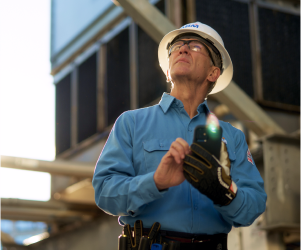The Eco Alchemist
Dr Michael Braungart explains the philosophy of cradle-to-cradle and how its influenced the current and evolving design industry, Deborah Erwin reports.
One of two brains behind the Cradle-To-Cradle paradigm, Dr Michael Braungart has an array of achievements tohis name. In partnership with American architect William McDonough, the German chemist co-founded McDonough Braungart Design Chemistry (MBDC) in 1995 and penned Cradle-To-Cradle: Remaking the Way We Make Things (2002). He has also lectured at a number of institutions since 1994, including the Technical University of Northeast Lower Saxony in Suderburg,Germany, Carnegie Mellon University in Pittsburgh and at the Darden School of Business at the University of Virginia (US). But Dr Braungart made his mark on the planet much earlier. In1987, at the age of 29, he began the Environmental Protection Encouragement Agency (EPEA) in Hamburg, Germany.This scientific research body works with businesses and governments to simultaneously develop products and address environmental issues.

He still bears the torch 23 years later as a reluctant Michael Moore of the industrial and product design world, with an indefatigable insistence to create within an Ecology-Equity-Economy triangle. Even though he has a solid presence in academia Dr Braungart is often found in the lab, workshop and factory as well, bridging educational and professional domains. Rather than communicate the cradle-to-cradle method with heavy, guilt-ridden and pompous overtones,he presents it as a pragmatic, intelligent and common sensical approach. The gist of Cradle-To-Cradle is simply to adopt a cyclical view of everything produced and eliminate the idea of waste from the equation. He explains that every product either belongs to a biological or technical cycle. “A biological cycle is for everything that is consumed, like food,detergent. The other is a technical cycle for things that are used for services like washing machines, office furniture and carpets.” And what served as the basis for Cradle-to-Cradle’s birth? “As Albert Einstein put it, ‘No problem can be solved by the same consciousness that created it.’ We saw in the late 80s that the existing design did not work”. EcoWorx carpet tiling is one his progenies. “Carpet gets dirty but overall it keeps the same material, therefore, we developed EcoWortz as a technical-cycle material. You don’t sell the carpet but the use of the carpet so you don’t need to use the cheapest materials”. Users can benefit from better acoustics, objects and indoor air quality (IAQ).Thoughtfully calibrated, this flooring alternative actually absorbs toxins in the air. EcoWorx is composed of polyolefin,a recycled material that is designed to go into a technical nutrient cycle; polypropylene, which comes from renewable resources and Nylon 6. This last ingredient “is the only polyamide which can quantitatively go back into technical cycles, different from Nylon 6-6 or other polyamides”, he explains. “It’s a technical nutrient material that is designed to go into the technosphere” (“The part of the physical environmentaffected through building and human modification,”according to McGraw-Hill Dictionary of Environmental Science). When developing a product, “First, you need to define whether you want to use materials for technical or biological cycles. Then you need to do an inventory of existing materials. Then you need to define where you want to go in terms of which materials you want to use and where you want to be in one, two and five years. The normal product development takes the usual pregnancy period,about nine months.”
What served as his motivation for creation? Simply self-esteem or the natural high from defying conventional bounds and doing good at the same time. “If you have to use the cheapest materials, then you will always generate an indoor air pollution problem for the ones who buy the carpet”. Aholistic product quality approach to carpets renders them as service products. He applauds Desso, a European carpet tile manufacturer for adopting the cradle-to-cradle methodology. He encourages others to jump on the bandwagon,not for any other reason than to feel good and reap the intrinsic rewards of making something that is good to the core. EcoWorx is one of 600 products developed with the cradle-to-cradle paradigm. “I am most proud to see young engineers get so much self esteem and positive maturation.there are hundreds and hundreds of engineers with bright shining eyes talking about what their cradle-to-cradle product developments are. It’s just nice. Before that, engineers viewed themselves as a burden on the planet where they always try to minimise their foot print to feel less guilty for being onthe planet. Now they feel proud and they see themselves aschange agents.”
He challenges people to evolve their way of thinking. “Traditionally,people thought of how to minimise their footprints,cradle-to-cradle is the strategy to have a footprint which is beneficial. Instead of reducing your footprint it’s about having a big footprint but make it productive for the economy, society and ecology at the same time. It’s not triple bottom line thinking, it’s triple top line thinking — Sustainability is all about being less bad. The approach of cradle-to-cradle builds upon sustainability. We need to understand toxicity and problems for ecology. It’s not about neglecting what has been achieved in the past, but it’s just not good enough”. He expresses the need for urgent action since “Less bad is just less bad, and to do less bad we have too many people. Even when you think about zero emissions and zero waste, you still think aboutwaste”. He explains, “Nature doesn’t know waste so if you tryto minimise, reduce or avoid waste you just make the wrong things more perfect. Cradle-to-cradle is the next step. We’ve now learned what makes problems, but now let’s think about nutrients, being beneficial instead of less bad. without blaming and shaming and the guilt management. It’s not about ethics anymore, it’s about holistic product quality”.
He underscores the neglected and often unknown issue of harmful IAQ. “In China, it’s not allowed for women to be in new buildings, in Shanghai, for example. They have to stay out of the building for half a year because they have such massive indoor air pollution problems. There are different types of legislation, especially for newly built houses. But even if you take an average European house the indoor air quality is three to eight times worse than the outside air”. In Shanghai, both the indoor and outdoor air quality is equally bad. “Sealing buildings to save energy makes it even worse.”
Effectiveness versus efficiency
He explains a difference between eco-efficiency and effectiveness. Efficiency means doing things in the right way. “I tried to explain to George Bush the difference between efficiency and effectiveness. Efficiency means doing things right, effectiveness means doing the right thing. If you run the electric chair in Texas with windmill energy, it’s still the wrong thing. First you need to ask, what is the right thing? Then what is the right material and what is the use of the material? Is it consumed,does it change by being used biologically, chemically, physically? You don’t consume a washing machine, you just use it. So we sell 300 times of washing instead of the washing machine”. Therefore, a manufacturer can employ the best materials rather than multiple cheap plastics that worsen IAQ and exacerbate pollution during their production. “For buildings, the first thing is to make them for indoor air quality.For example, when I worked with Desso, the carpets are not just non-stinking, but they actively clean the air. Because of all the contaminants we find in that building – toner dust, paints, glues — being less toxic is not enough. We need to make products that actively clean air. The carpet contains microbes that actively eat contaminants”. He enthuses about a shift in sales approaches, where a service is sold rather than its packaging. “There are a lot of innovations around building materials. For example, we have windows on the market but we’re no longer selling the window but 25 years of looking through it because you cannot make a window without using environmentally toxic stuff but you can make sure that chemicals aren’t released while the windows are in use”.
He puts the onus on designers and manufacturers to create responsibly. “The customer doesn’t know what’s in the product,so he or she takes risks without knowing” and warns of the uncalculated costs to the environment. “People in China and India are contaminating the biological cycles massively because they don’t see that the chief materials of a TV set, for instance, are not intended to go into biological cycles. In China and India they use an old way of thinking, reusing PVC for carpets and then say it’s recycling. It makes the wrong things perfect”.
One pertinent example for the building industry involves primitive steel recycling. “By putting a used vehicle into building materials, you lose all the rare metals in the process — chromium,manganese, nickel, antimone — all different types. They all get diluted, meaning that new buildings are missing these rare metals”. He underlines the need for rare metals: “When the content of copper is higher than 0.5 percent, which is sometimes the case, the steel is very vulnerable to earthquakes– it breaks rapidly and immediately. We saw this in Turkey in 1999, 20,000 people died in an earthquake because nobody looked at the copper content of the steel. The copper content is also higher in copper ore. Copper is far more critical than oil in the future, because it.s so much more rare”. Same with concrete. “They basically put anything that works into concrete, without seeing the massive problems related to unhealthy concrete additives. There are only a few projects that really make sense overall. What they do is they make the same standard architecture, one size fits all . and this is done all over the planet — not at all respecting the local needs and climate. The real innovative architecture in China is less than two percent. The rest ignore any needs of the people, the need for rare metals and the needs of the environment”.
Other building materials have also made a splash on the market.There are paints that actively clean air, walls with latentheat/cooling properties, hi-crete, a hydrophobic concreteoption which protects steel from corrosion, and an array of geopolymers (local soil mixed with a low percentage of Portland concrete). Dr Braungart names Desso carpets and AKZO Nobel paints as two companies that operate within the cradle-to-cradle framework. What he ultimately hopes to drive home is, “Green does not incorporate a broad range of environmental problems whereas Cradle-to-Cradle is an inclusive beneficial overarching philosophy”.




